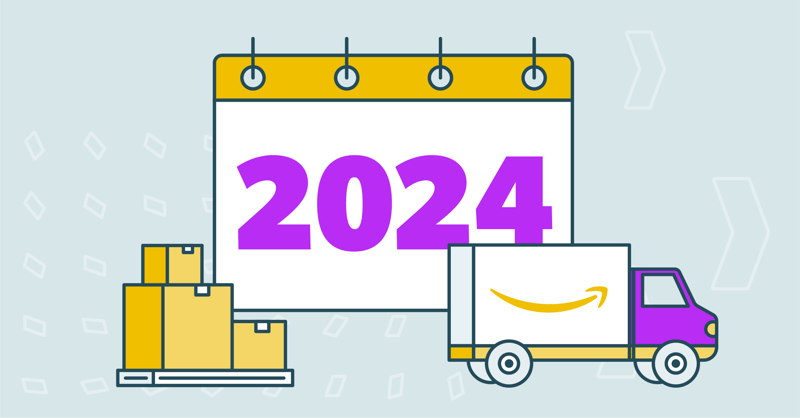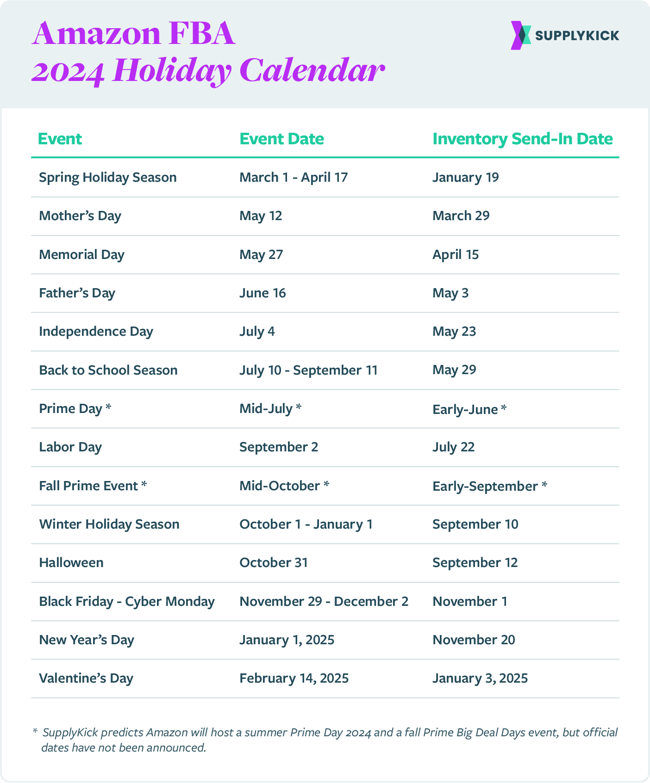
You can have the best product on Amazon, with top-notch marketing and advertising, but if shoppers can't purchase your product because it's out of stock, it's all irrelevant. From supply chain challenges and inventory stockouts to shifting consumer behavior and steep competition, there's no shortage of factors that impact Amazon FBA sellers each year. To rise above the ever-changing (and often unpredictable) ecommerce landscape, you must have an effective inventory forecasting plan—one that ensures you have sufficient product available during Amazon's peak shopping seasons and proactively prevents both excess inventory and stockouts throughout the year.
As you prepare your 2024 Amazon marketplace strategy, two big questions are: "When should I send in my FBA inventory to ensure it's received on time?" and "How do I ensure there are no gaps in my available FBA inventory so that my product is always in stock?" To help simplify your fulfillment planning, our team of Amazon experts has created the 2024 Amazon FBA Holiday Calendar and Checklist.
This calendar outlines the most important peak Amazon shopping dates and when to send your inventory to Amazon's Fulfillment Centers (FCs) to help keep your stock levels on track all year long (be sure to bookmark it for a quick reference throughout the year!):

| • | Spring Holiday Season (Spring Break, St. Patrick's Day, Easter, etc): March 1 - April 17 | Inventory Send-In Date: January 19 |
| • | Mother’s Day: May 12 | Inventory Send-In Date: March 29 |
| • | Memorial Day: May 27 | Inventory Send-In Date: April 15 |
| • | Father’s Day: June 16 | Inventory Send-In Date: May 3 |
| • | Independence Day: July 4 | Inventory Send-In Date: May 23 |
| • | Back to School Season: July 10 - September 11 | Inventory Send-In Date: May 29 |
| • | Prime Day*: Mid-July* | Inventory Send-In Date: Early-June* |
| • | Labor Day: September 2 | Inventory Send-In Date: July 22 |
| • | Prime Big Deal Days*: Mid-October* | Inventory Send-In Date: Early-September* |
| • | Winter Holiday Shopping Season: October 1 - January 1 | Inventory Send-In Date: September 10 |
| • | Halloween: October 31 | Inventory Send-In Date: September 12 |
| • | Black Friday - Cyber Monday: November 29 - December 2 | Inventory Send-In Date: November 1 |
| • | New Year's Day: January 1, 2025 | Inventory Send-In Date: November 20 |
| • | Valentine’s Day: February 14, 2025 | Inventory Send-In Date: January 3, 2025 |
| *SupplyKick predicts Amazon will host a summer Prime Day 2024 and a fall Prime Big Deal Days event, but official dates have not been announced. | |
FBA Seller Pro Tip: While this calendar should help you maintain appropriate stock levels, it's crucial to anticipate and accommodate any seasonality or specific trends related to your brand, customers, and product assortment.
When it comes to FBA inventory receiving and processing times, a variety of factors come into play. Shipment types, shipment origins, quantities, and the number of Amazon FCs receiving your inventory can affect how quickly Amazon can process your products. For example, we've found that Parcel shipping usually takes an average of one week to deliver and receive, while Less-Than-Truckload (LTL) shipments take quite a bit longer—about two to three weeks to deliver and receive, sometimes longer depending on the fulfillment center's capacity.
If you're experiencing issues with FBA storage limits and stockouts, Amazon offers AWD (Amazon Warehousing & Distribution) as a 3PL and bulk storage solution for sellers. The solution allows FBA sellers to avoid stockouts and auto-replenish inventory directly into Amazon FCs.
FBA Seller Pro Tip: Amazon's fulfillment centers typically take 2-3 weeks to process inventory; however, if you want or need to be extra cautious with your stock levels, 3-4 weeks is a more conservative approach to ensure everything is in stock.
Amazon plans to roll out several FBA fees in 2024, impacting both fulfillment and referral rates. 2024 US Amazon FBA Fulfillment fee changes include:
|
DECREASED Fees In:
|
INCREASED Fees In:
|
NEW Fees:
|
||||||||||||||||||||
|
|
|
FBA Seller Pro Tip: Keep an eye out for these FBA fee changes and adjust your inventory plans, forecasting, and product pricing accordingly.
As you plan your Amazon inventory lineup for 2024, take a close look at how seasonality impacts your customers' behavior—and remember that Amazon category sales can fluctuate based on the season as well as the constantly evolving macroeconomic environment.
Late winter and spring often spur sales increases in Sports & Outdoor, Luggage & Travel Gear, Tools & Home Improvement, and Patio, Lawn & Garden products as shoppers gear up for spring break vacations or spruce up their yards for warm-weather activities. On the other hand, categories like Toys & Games, Handmade, and Sports & Fitness shine during the winter months as consumers purchase holiday gifts and prep for their New Year's resolutions. Be sure your inventory forecast accounts for any seasonal shifts to avoid the risk of stockouts or accumulating aging inventory.
FBA Seller Pro Tip: Each category has its own peak holiday shopping dates, so be sure to research the most important holidays for your brand and customers—on Amazon and other marketplaces.
In 2023, Amazon hosted two distinct Prime events. In addition to maintaining the standard mid-summer Prime Day 2023, Amazon kicked off the Q4 2023 holiday shopping season with Prime Big Deal Days. These 48-hour events took place for Prime members in the US, Canada, Mexico, UK, and more.
We predict they'll continue the tradition for 2024, capitalizing on summer and winter peak shopping seasons. Still, Amazon is notorious for announcing official dates just weeks before the big sales events—keeping brands, retailers, and other ecommerce marketplace competitors (Target Plus, Walmart.com, Lowe's) on their toes. Be sure to create your game plan well before the big sales days—and check out this Prime Day Events seller guide for strategies to quickly pivot and capitalize on increased platform traffic and Prime Exclusive Discounts.
Amazon hasn't announced any FBA cut-off dates for their 2024 Prime Day events, but we'll update this post as soon as they do, so be sure to check back!
FBA Seller Pro Tip: When prepping for Amazon Prime Day events, review your performance and sales data from previous Prime Events—and fine-tune your strategy with a focus on inventory forecasting, keyword research, listing optimization, and advertising performance.
Speaking of Amazon peak seasons, consumers seem to start their holiday shopping earlier each year—this is now the new normal, with the holiday shopping season kicking off well before Black Friday and even Halloween, as early as October 1. In Q4 2023, retailers like Amazon, Target+, and Walmart cashed in on top-selling shopping windows by offering promotions earlier, even encouraging sellers to extend their promotion window from the traditional 5-day length to 11 days. Additionally, Amazon suggested brands launch their Black Friday and Cyber Monday advertising campaigns at the beginning of the Thanksgiving week (rather than closer to the peak shopping days).
Keep in mind that almost half of Amazon consumers say they shop for themselves during the holidays. So, even if you don't offer "giftable" items, you can still benefit from the increased platform traffic and consumer spending throughout Q4. Closely monitor customer behavior and big box retailer promotions, and plan your inventory send-in, competitive pricing and coupon strategies, packaging inserts, and Amazon Ads budget accordingly. Find more logistics, advertising, and marketing tips to increase Amazon sales in Q4 here.
FBA Seller Pro Tip: During peak shopping seasons, Amazon may prioritize shipping out orders, so keep an eye on Amazon FC receiving times and adapt your inventory send-in dates to reduce the risk of stockouts.
Whether it's your brand's peak sales season or the Q4 holiday rush, success on Amazon means building a holistic, well-thought-out strategy across logistics, pricing, marketing, advertising, and customer service. Use this checklist to stay on track, implement best practices (we have an Amazon Marketing & Advertising Playbook to help with that), and set yourself up for success ahead of time.
 |
|
|
|
||||||||||||||||||||||||||||||
|
|
|
FBA Seller Pro Tip: Brand Registered sellers can create and schedule holiday-specific Amazon Stores—be sure to take advantage of this feature to create seasonal content, drive more traffic to your products, and engage with shoppers!
Whether you're currently selling FBA, want to move to a single-seller model, or are looking to switch from Vendor to Seller Central, SupplyKick can help create an optimal inventory strategy for your brand—either as a trusted third-party seller of your products, or as an Amazon agency consultant serving as an extension of your team. With hundreds of partners and over a decade of Amazon selling experience, SupplyKick specializes in working with high-potential brands who want to achieve more but don't have the time, expertise, or resources necessary to excel on today's leading marketplaces.
Our inventory forecasting analysts help you navigate any supply chain challenges you're currently facing and track trends to keep up with demand and reduce stockouts. Selling on Amazon can get complicated, but it doesn't have to be. Connect with our team.
Lorem ipsum dolor sit amet, consectetur adipiscing elit


Sign up to receive our newsletter for growth strategies, important updates, inventory and policy changes, and best practices.
These Stories on Logistics & Fulfillment
For press inquiries, please contact Molly Horstmann, mhorstmann@supplykick.com